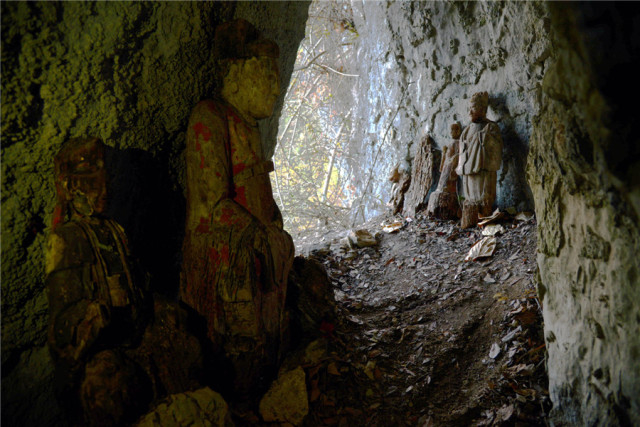A group of 12 carved wood Buddhist and Taoist statues have been rediscovered in a cave in southwest China’s Chongqing municipality. The statues are remarkably preserved, considering the cave has three openings where rain and water can enter.
The wood carvings are thought to date to the late Qing Dynasty (about 1860 to the early 1900s) and depict different vivid forms and lifelike images. The tallest is about 1.3 meters (4.3 feet) tall and the shortest is less than 20 centimeters (8 inches) tall.
[flagallery gid=118]
Journalist Liu Xinmin from the People’s Daily newspaper was guided to the cave — located in Shengji village, Shangba township, Yunyang county — last week by local villagers.
The group climbed ropes on Jiaoding mountain for more than an hour before reaching the narrow opening at 1,760 meters (5,774.28 feet) above sea level, he said.
Liu said the cave was likely formed by a falling boulder about 2 square meters (21.5 square feet) and about 3 meters high (9.8 feet). The cave has openings on both sides that allows light to shine in. The top of the cave also has a hole where rain can enter.
Locals said a well-known painting craftsman named Li Benzhu, made the statutes in the late Qing Dynasty using a variety of local sandalwood. They include carvings of the Shan Wang (mountain king) bodhisattva, the Guanyin bodhisattva, the Yao Wang (medicine king) bodhisattva, the Taishang laojun (a supreme god of Taoism) and a few attendants and seated animals of the Jade Emperor (also Taoist).
The carvings once totaled 32, but due to wind and rain damage, only the 12 remain, as the rest rotted away. Many of the remaining statues still have parts of their original gilding.
According to Huang Fangshu, a local who is 73 year old, the cave was once a temple that housed a large bell.
Local legend has it that the bell was flown to this spot from Kaixian county (about 40 miles away), Huang recounted.
“When people heard the story of the bell flying here, they heard an ‘Om, Om, Om” sound,” Huang said. “After it fell here, the local people build a temple, and called it Chuanzu temple.”
Chuanzu refers to ancestors of Sichuan province, which Chongqing was once a part of when the statues were made.
Relics made of wood decay faster than other materials; that they survived exposed to the elements is significant.
Some researchers believe the oldest wood statue is a Shigir idol from the Mesolithic era found in Siberia in 1890. Twice as old as the Egyptian pyramids, the idol was protected for thousands of years because it was surrounded by a four-meter layer of peat bog, according to the Siberian Times.
Story compiled with information translated from People’s Daily.
 CGTN America
CGTN America

